A Doll's House, Act 2: Exploring Themes, Characters, and Relationships
VerifiedAdded on 2022/08/24
|7
|1467
|26
Homework Assignment
AI Summary
This assignment offers a comprehensive analysis of Act 2 of Henrik Ibsen's 'A Doll's House', addressing key questions about the play. It examines the symbolism of the Christmas tree, highlighting its role in foreshadowing Nora's transformation. The document explores Kristine's suspicions regarding the loan and details instances of secrets and hidden information within the act. It also delves into the audience's understanding of Dr. Rank's character, his relationship with Nora, and his role in the plot. The assignment includes a character evaluation chart, providing textual evidence to assess the relationships between Nora and the male figures in her life, including Torvald, Dr. Rank, and Krogstad. The analysis covers their interactions, motivations, and the evolving dynamics of the Helmer household, contributing to a deeper understanding of the play's themes of deception, societal expectations, and self-discovery.
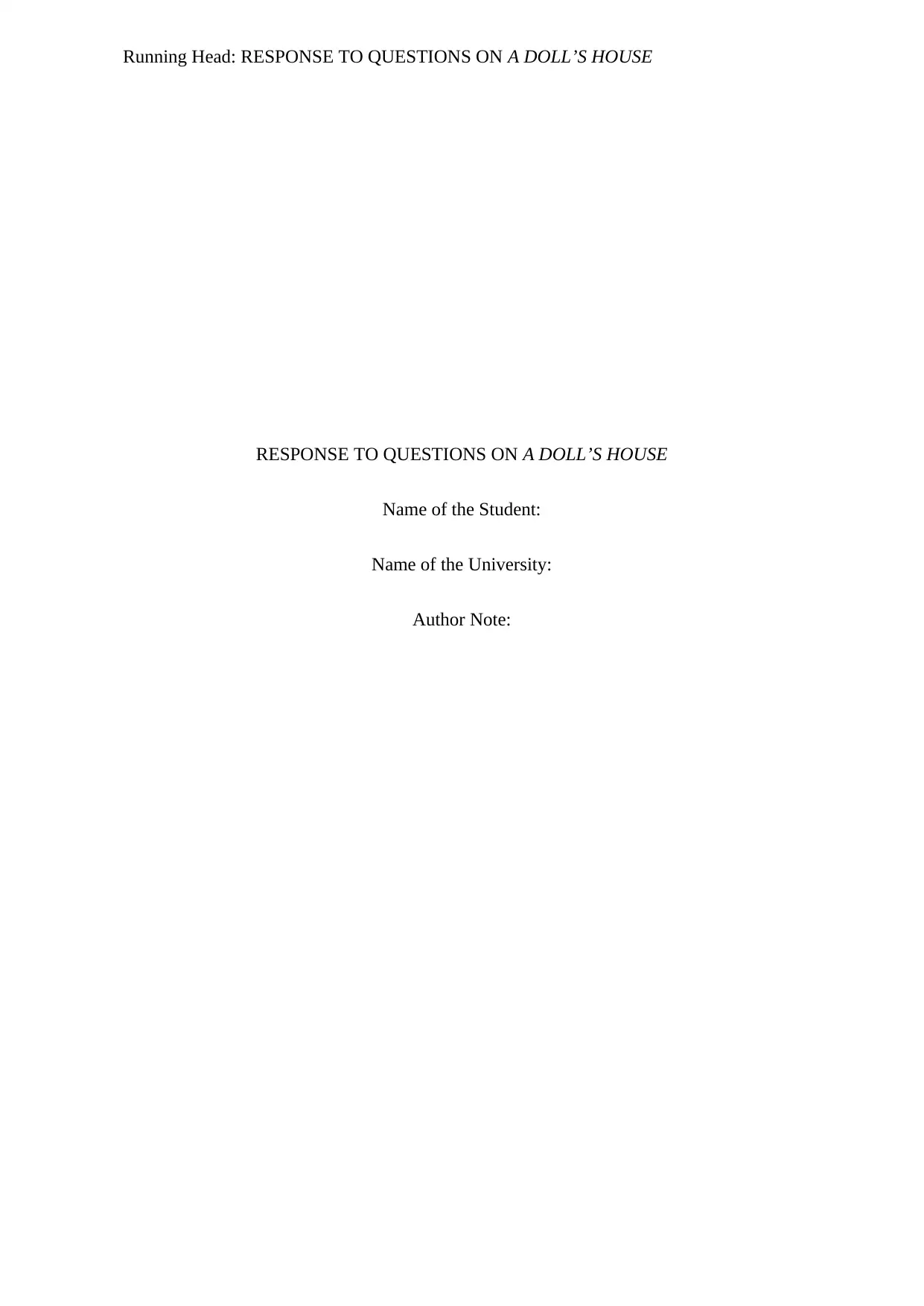
Running Head: RESPONSE TO QUESTIONS ON A DOLL’S HOUSE
RESPONSE TO QUESTIONS ON A DOLL’S HOUSE
Name of the Student:
Name of the University:
Author Note:
RESPONSE TO QUESTIONS ON A DOLL’S HOUSE
Name of the Student:
Name of the University:
Author Note:
Paraphrase This Document
Need a fresh take? Get an instant paraphrase of this document with our AI Paraphraser
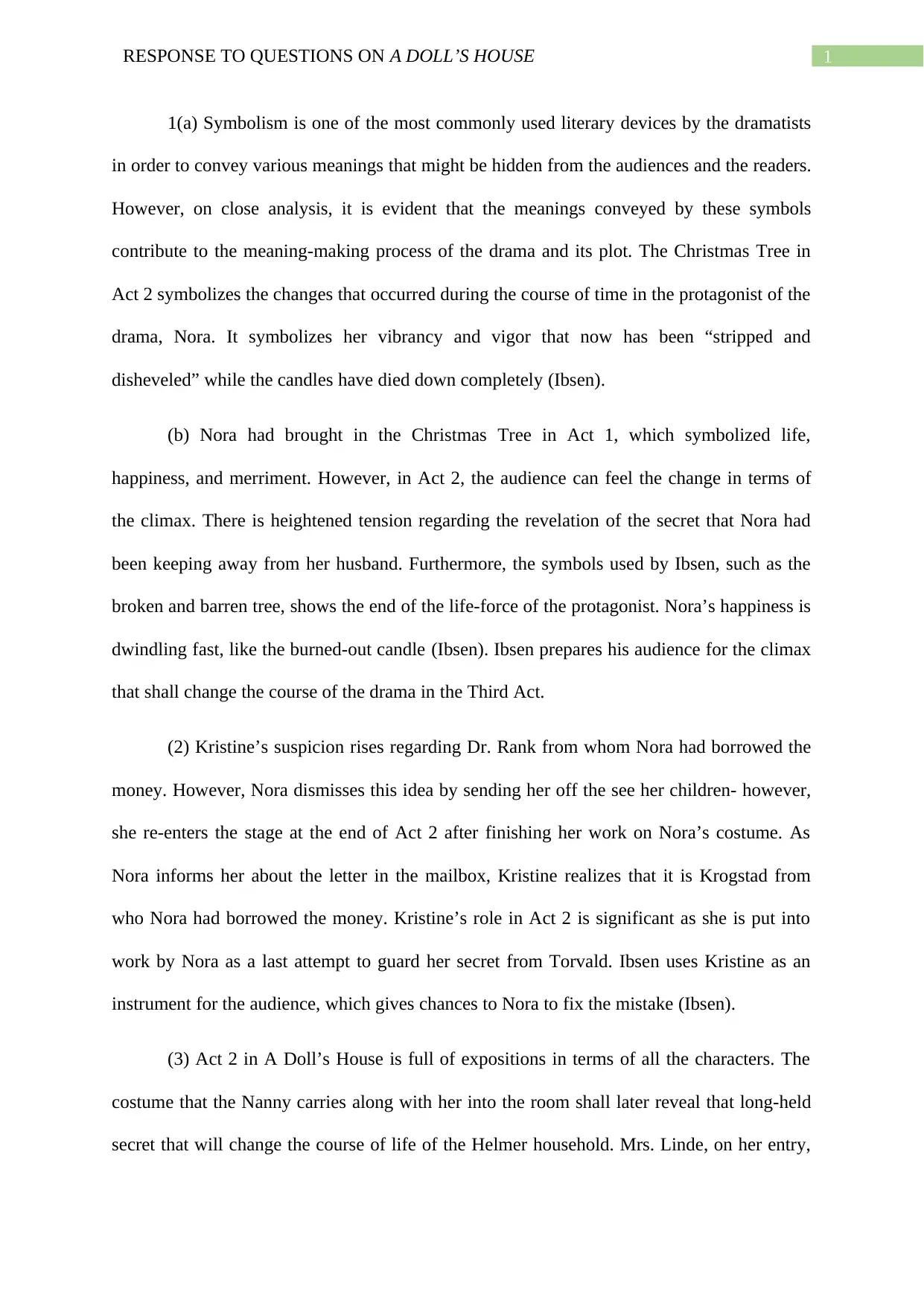
1RESPONSE TO QUESTIONS ON A DOLL’S HOUSE
1(a) Symbolism is one of the most commonly used literary devices by the dramatists
in order to convey various meanings that might be hidden from the audiences and the readers.
However, on close analysis, it is evident that the meanings conveyed by these symbols
contribute to the meaning-making process of the drama and its plot. The Christmas Tree in
Act 2 symbolizes the changes that occurred during the course of time in the protagonist of the
drama, Nora. It symbolizes her vibrancy and vigor that now has been “stripped and
disheveled” while the candles have died down completely (Ibsen).
(b) Nora had brought in the Christmas Tree in Act 1, which symbolized life,
happiness, and merriment. However, in Act 2, the audience can feel the change in terms of
the climax. There is heightened tension regarding the revelation of the secret that Nora had
been keeping away from her husband. Furthermore, the symbols used by Ibsen, such as the
broken and barren tree, shows the end of the life-force of the protagonist. Nora’s happiness is
dwindling fast, like the burned-out candle (Ibsen). Ibsen prepares his audience for the climax
that shall change the course of the drama in the Third Act.
(2) Kristine’s suspicion rises regarding Dr. Rank from whom Nora had borrowed the
money. However, Nora dismisses this idea by sending her off the see her children- however,
she re-enters the stage at the end of Act 2 after finishing her work on Nora’s costume. As
Nora informs her about the letter in the mailbox, Kristine realizes that it is Krogstad from
who Nora had borrowed the money. Kristine’s role in Act 2 is significant as she is put into
work by Nora as a last attempt to guard her secret from Torvald. Ibsen uses Kristine as an
instrument for the audience, which gives chances to Nora to fix the mistake (Ibsen).
(3) Act 2 in A Doll’s House is full of expositions in terms of all the characters. The
costume that the Nanny carries along with her into the room shall later reveal that long-held
secret that will change the course of life of the Helmer household. Mrs. Linde, on her entry,
1(a) Symbolism is one of the most commonly used literary devices by the dramatists
in order to convey various meanings that might be hidden from the audiences and the readers.
However, on close analysis, it is evident that the meanings conveyed by these symbols
contribute to the meaning-making process of the drama and its plot. The Christmas Tree in
Act 2 symbolizes the changes that occurred during the course of time in the protagonist of the
drama, Nora. It symbolizes her vibrancy and vigor that now has been “stripped and
disheveled” while the candles have died down completely (Ibsen).
(b) Nora had brought in the Christmas Tree in Act 1, which symbolized life,
happiness, and merriment. However, in Act 2, the audience can feel the change in terms of
the climax. There is heightened tension regarding the revelation of the secret that Nora had
been keeping away from her husband. Furthermore, the symbols used by Ibsen, such as the
broken and barren tree, shows the end of the life-force of the protagonist. Nora’s happiness is
dwindling fast, like the burned-out candle (Ibsen). Ibsen prepares his audience for the climax
that shall change the course of the drama in the Third Act.
(2) Kristine’s suspicion rises regarding Dr. Rank from whom Nora had borrowed the
money. However, Nora dismisses this idea by sending her off the see her children- however,
she re-enters the stage at the end of Act 2 after finishing her work on Nora’s costume. As
Nora informs her about the letter in the mailbox, Kristine realizes that it is Krogstad from
who Nora had borrowed the money. Kristine’s role in Act 2 is significant as she is put into
work by Nora as a last attempt to guard her secret from Torvald. Ibsen uses Kristine as an
instrument for the audience, which gives chances to Nora to fix the mistake (Ibsen).
(3) Act 2 in A Doll’s House is full of expositions in terms of all the characters. The
costume that the Nanny carries along with her into the room shall later reveal that long-held
secret that will change the course of life of the Helmer household. Mrs. Linde, on her entry,
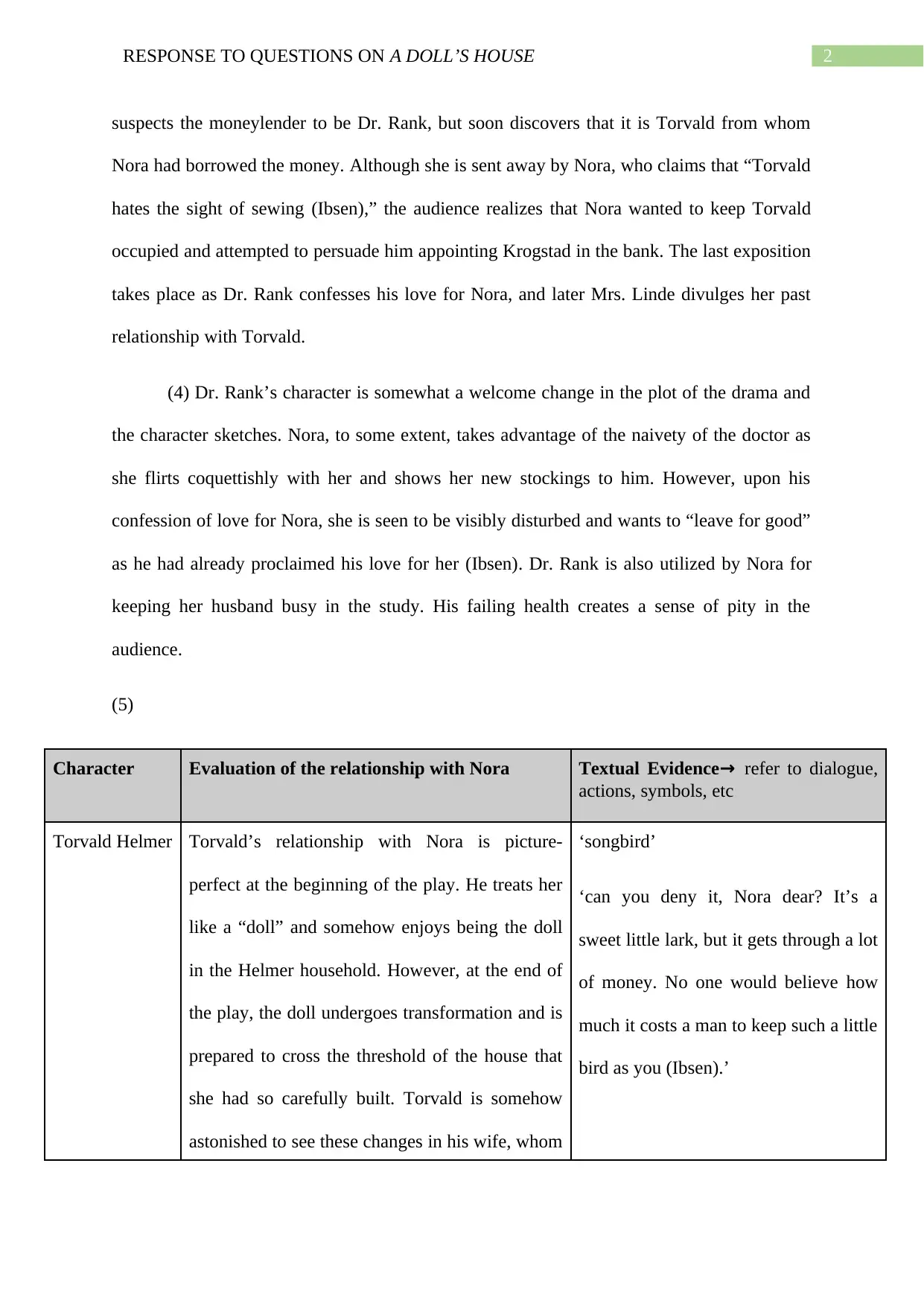
2RESPONSE TO QUESTIONS ON A DOLL’S HOUSE
suspects the moneylender to be Dr. Rank, but soon discovers that it is Torvald from whom
Nora had borrowed the money. Although she is sent away by Nora, who claims that “Torvald
hates the sight of sewing (Ibsen),” the audience realizes that Nora wanted to keep Torvald
occupied and attempted to persuade him appointing Krogstad in the bank. The last exposition
takes place as Dr. Rank confesses his love for Nora, and later Mrs. Linde divulges her past
relationship with Torvald.
(4) Dr. Rank’s character is somewhat a welcome change in the plot of the drama and
the character sketches. Nora, to some extent, takes advantage of the naivety of the doctor as
she flirts coquettishly with her and shows her new stockings to him. However, upon his
confession of love for Nora, she is seen to be visibly disturbed and wants to “leave for good”
as he had already proclaimed his love for her (Ibsen). Dr. Rank is also utilized by Nora for
keeping her husband busy in the study. His failing health creates a sense of pity in the
audience.
(5)
Character Evaluation of the relationship with Nora Textual Evidence→ refer to dialogue,
actions, symbols, etc
Torvald Helmer Torvald’s relationship with Nora is picture-
perfect at the beginning of the play. He treats her
like a “doll” and somehow enjoys being the doll
in the Helmer household. However, at the end of
the play, the doll undergoes transformation and is
prepared to cross the threshold of the house that
she had so carefully built. Torvald is somehow
astonished to see these changes in his wife, whom
‘songbird’
‘can you deny it, Nora dear? It’s a
sweet little lark, but it gets through a lot
of money. No one would believe how
much it costs a man to keep such a little
bird as you (Ibsen).’
suspects the moneylender to be Dr. Rank, but soon discovers that it is Torvald from whom
Nora had borrowed the money. Although she is sent away by Nora, who claims that “Torvald
hates the sight of sewing (Ibsen),” the audience realizes that Nora wanted to keep Torvald
occupied and attempted to persuade him appointing Krogstad in the bank. The last exposition
takes place as Dr. Rank confesses his love for Nora, and later Mrs. Linde divulges her past
relationship with Torvald.
(4) Dr. Rank’s character is somewhat a welcome change in the plot of the drama and
the character sketches. Nora, to some extent, takes advantage of the naivety of the doctor as
she flirts coquettishly with her and shows her new stockings to him. However, upon his
confession of love for Nora, she is seen to be visibly disturbed and wants to “leave for good”
as he had already proclaimed his love for her (Ibsen). Dr. Rank is also utilized by Nora for
keeping her husband busy in the study. His failing health creates a sense of pity in the
audience.
(5)
Character Evaluation of the relationship with Nora Textual Evidence→ refer to dialogue,
actions, symbols, etc
Torvald Helmer Torvald’s relationship with Nora is picture-
perfect at the beginning of the play. He treats her
like a “doll” and somehow enjoys being the doll
in the Helmer household. However, at the end of
the play, the doll undergoes transformation and is
prepared to cross the threshold of the house that
she had so carefully built. Torvald is somehow
astonished to see these changes in his wife, whom
‘songbird’
‘can you deny it, Nora dear? It’s a
sweet little lark, but it gets through a lot
of money. No one would believe how
much it costs a man to keep such a little
bird as you (Ibsen).’
⊘ This is a preview!⊘
Do you want full access?
Subscribe today to unlock all pages.

Trusted by 1+ million students worldwide
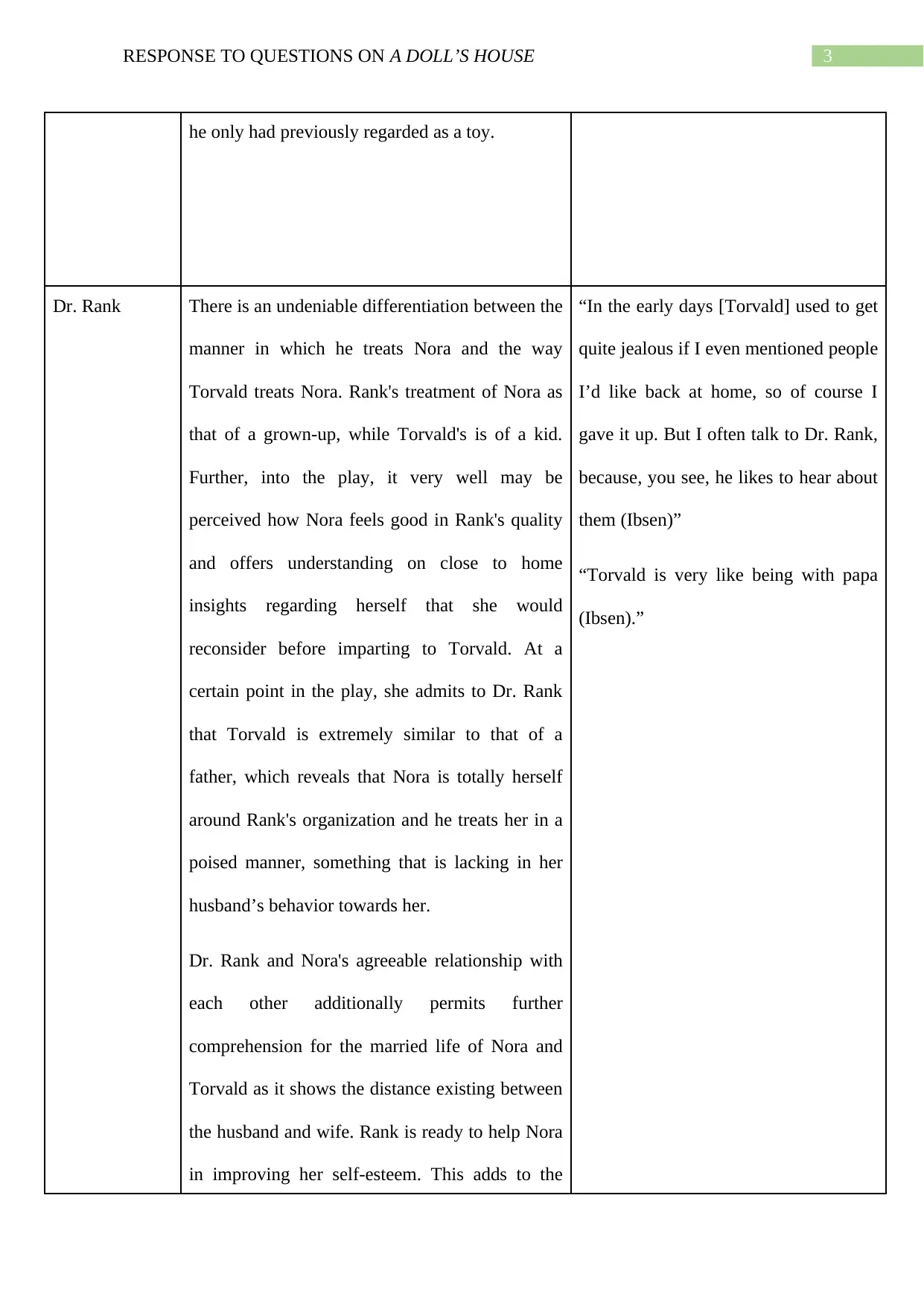
3RESPONSE TO QUESTIONS ON A DOLL’S HOUSE
he only had previously regarded as a toy.
Dr. Rank There is an undeniable differentiation between the
manner in which he treats Nora and the way
Torvald treats Nora. Rank's treatment of Nora as
that of a grown-up, while Torvald's is of a kid.
Further, into the play, it very well may be
perceived how Nora feels good in Rank's quality
and offers understanding on close to home
insights regarding herself that she would
reconsider before imparting to Torvald. At a
certain point in the play, she admits to Dr. Rank
that Torvald is extremely similar to that of a
father, which reveals that Nora is totally herself
around Rank's organization and he treats her in a
poised manner, something that is lacking in her
husband’s behavior towards her.
Dr. Rank and Nora's agreeable relationship with
each other additionally permits further
comprehension for the married life of Nora and
Torvald as it shows the distance existing between
the husband and wife. Rank is ready to help Nora
in improving her self-esteem. This adds to the
“In the early days [Torvald] used to get
quite jealous if I even mentioned people
I’d like back at home, so of course I
gave it up. But I often talk to Dr. Rank,
because, you see, he likes to hear about
them (Ibsen)”
“Torvald is very like being with papa
(Ibsen).”
he only had previously regarded as a toy.
Dr. Rank There is an undeniable differentiation between the
manner in which he treats Nora and the way
Torvald treats Nora. Rank's treatment of Nora as
that of a grown-up, while Torvald's is of a kid.
Further, into the play, it very well may be
perceived how Nora feels good in Rank's quality
and offers understanding on close to home
insights regarding herself that she would
reconsider before imparting to Torvald. At a
certain point in the play, she admits to Dr. Rank
that Torvald is extremely similar to that of a
father, which reveals that Nora is totally herself
around Rank's organization and he treats her in a
poised manner, something that is lacking in her
husband’s behavior towards her.
Dr. Rank and Nora's agreeable relationship with
each other additionally permits further
comprehension for the married life of Nora and
Torvald as it shows the distance existing between
the husband and wife. Rank is ready to help Nora
in improving her self-esteem. This adds to the
“In the early days [Torvald] used to get
quite jealous if I even mentioned people
I’d like back at home, so of course I
gave it up. But I often talk to Dr. Rank,
because, you see, he likes to hear about
them (Ibsen)”
“Torvald is very like being with papa
(Ibsen).”
Paraphrase This Document
Need a fresh take? Get an instant paraphrase of this document with our AI Paraphraser
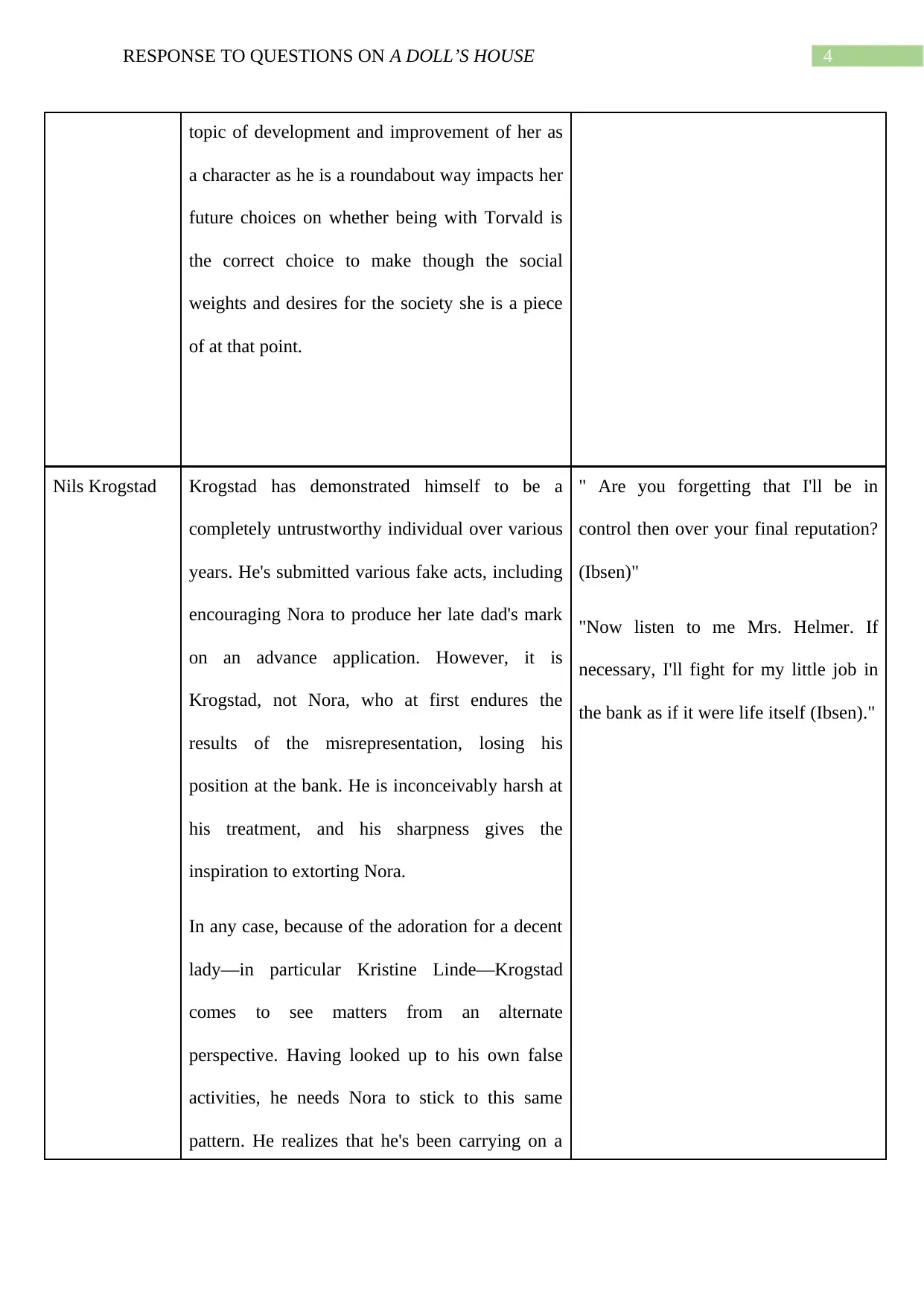
4RESPONSE TO QUESTIONS ON A DOLL’S HOUSE
topic of development and improvement of her as
a character as he is a roundabout way impacts her
future choices on whether being with Torvald is
the correct choice to make though the social
weights and desires for the society she is a piece
of at that point.
Nils Krogstad Krogstad has demonstrated himself to be a
completely untrustworthy individual over various
years. He's submitted various fake acts, including
encouraging Nora to produce her late dad's mark
on an advance application. However, it is
Krogstad, not Nora, who at first endures the
results of the misrepresentation, losing his
position at the bank. He is inconceivably harsh at
his treatment, and his sharpness gives the
inspiration to extorting Nora.
In any case, because of the adoration for a decent
lady—in particular Kristine Linde—Krogstad
comes to see matters from an alternate
perspective. Having looked up to his own false
activities, he needs Nora to stick to this same
pattern. He realizes that he's been carrying on a
" Are you forgetting that I'll be in
control then over your final reputation?
(Ibsen)"
"Now listen to me Mrs. Helmer. If
necessary, I'll fight for my little job in
the bank as if it were life itself (Ibsen)."
topic of development and improvement of her as
a character as he is a roundabout way impacts her
future choices on whether being with Torvald is
the correct choice to make though the social
weights and desires for the society she is a piece
of at that point.
Nils Krogstad Krogstad has demonstrated himself to be a
completely untrustworthy individual over various
years. He's submitted various fake acts, including
encouraging Nora to produce her late dad's mark
on an advance application. However, it is
Krogstad, not Nora, who at first endures the
results of the misrepresentation, losing his
position at the bank. He is inconceivably harsh at
his treatment, and his sharpness gives the
inspiration to extorting Nora.
In any case, because of the adoration for a decent
lady—in particular Kristine Linde—Krogstad
comes to see matters from an alternate
perspective. Having looked up to his own false
activities, he needs Nora to stick to this same
pattern. He realizes that he's been carrying on a
" Are you forgetting that I'll be in
control then over your final reputation?
(Ibsen)"
"Now listen to me Mrs. Helmer. If
necessary, I'll fight for my little job in
the bank as if it were life itself (Ibsen)."
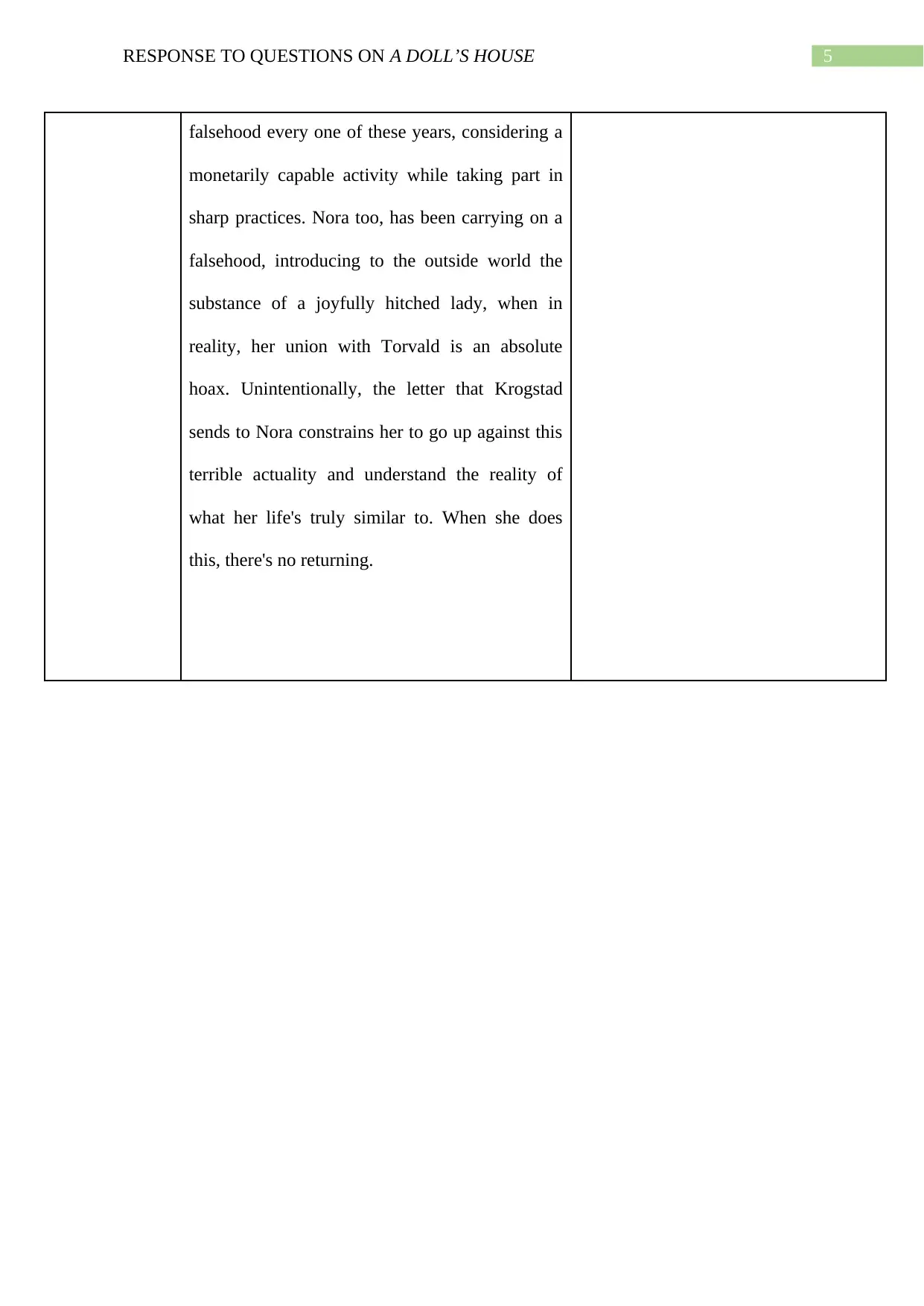
5RESPONSE TO QUESTIONS ON A DOLL’S HOUSE
falsehood every one of these years, considering a
monetarily capable activity while taking part in
sharp practices. Nora too, has been carrying on a
falsehood, introducing to the outside world the
substance of a joyfully hitched lady, when in
reality, her union with Torvald is an absolute
hoax. Unintentionally, the letter that Krogstad
sends to Nora constrains her to go up against this
terrible actuality and understand the reality of
what her life's truly similar to. When she does
this, there's no returning.
falsehood every one of these years, considering a
monetarily capable activity while taking part in
sharp practices. Nora too, has been carrying on a
falsehood, introducing to the outside world the
substance of a joyfully hitched lady, when in
reality, her union with Torvald is an absolute
hoax. Unintentionally, the letter that Krogstad
sends to Nora constrains her to go up against this
terrible actuality and understand the reality of
what her life's truly similar to. When she does
this, there's no returning.
⊘ This is a preview!⊘
Do you want full access?
Subscribe today to unlock all pages.

Trusted by 1+ million students worldwide

6RESPONSE TO QUESTIONS ON A DOLL’S HOUSE
Work Cited
Ibsen, Henrik, et al. A doll's house. Caedmon, 1971.
Work Cited
Ibsen, Henrik, et al. A doll's house. Caedmon, 1971.
1 out of 7
Related Documents
Your All-in-One AI-Powered Toolkit for Academic Success.
+13062052269
info@desklib.com
Available 24*7 on WhatsApp / Email
![[object Object]](/_next/static/media/star-bottom.7253800d.svg)
Unlock your academic potential
Copyright © 2020–2025 A2Z Services. All Rights Reserved. Developed and managed by ZUCOL.




